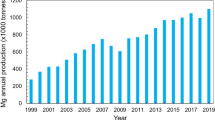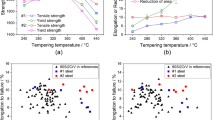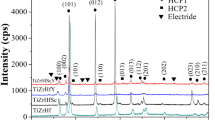Abstract
Microstructural evolution of an Fe–18.1%Ni–34.9%Co–9.3%Ti (in at.%) in processing by high-pressure torsion (HPT) was investigated by electron backscatter diffraction. After 10 turns of HPT straining at room temperature with a rotation speed of 1 rpm under a pressure of 6 GPa, the alloy was composed of body-centered cubic-structured grains with sizes of 20–50 nm having high density crystal defects inside the grains. The mechanism of this significant grain refinement was discussed in relation to the stress-induced martensitic transformation and transgranular shear near ideal strength. The actual shear stress of the nanocrystalline iron-based alloy was estimated to be 1.37 GPa and as high as 38% of the ideal shear stress, which is similar to Gum Metal exhibiting deformation without dislocation activity. It is inferred from these results that the dislocation motion can be suppressed up to ultrahigh stress level near ideal strength by the formation of nano-sized grains.










Similar content being viewed by others
References
Valiev RZ (2004) Nature Mater 3:511
Segal VM, Reznikov VI, Drobyshevskiy AE, Kopylov VI (1981) Russ Metall 1:99
Saito Y, Tsuji N, Utsunomiya H, Sakaki T, Hong RG (1998) Scr Mater 39:1221
Bridgman PW (1935) Phys Rev 48:825
Kuramoto S, Furuta T, Nagasako N, Horita Z (2009) Appl Phys Lett 211901 1–211901 3
Taylor GI (1934) Proc R Soc A 145:362
Orowan E (1934) Zeit Phys 89:605
Polanyi M (1934) Zeit Phys 89:660
Whang Y, Chen M, Zhou F, Ma E (2002) Nature 419:912
Saito T, Furuta T, Hwang JH, Kuramoto S, Nishino K, Suzuki N, Chen R, Yamada A, Ito K, Seno Y, Nonaka T, Ikehata H, Nagasako N, Iwamoto C, Ikuhara Y, Sakuma T (2003) Science 300:464
Wetscher F, Vorhauer A, Stock R, Pippan R (2004) Mater Sci Eng A 387–389:809
Esrtrin Y, Molitnikov A, Davies CHJ, Lapovok R (2008) J Mech Phys Solids 56:1186
Furuta T, Kuramoto S, Ohsuna T, Horita Z (2010) In: Proceedings of the 2nd international symposium on steel science (ISSS 2009), 21–24 October 2009, The Iron and Steel Institute of Japan, ISSS, Kyoto, Japan (in press)
Morito S, Tanaka H, Konishi R, Furuhara T, Maki T (2003) Acta Mater 51:1789
Zhilyaev AP, Langdon TG (2008) Prog Mater Sci 53:893
Tsuji N, Maki T (2009) Scr Mater 60:1044
Zhao YH, Liao XZ, Horita Z, Langdon TG, Zhu YT (2008) Mater Sci Eng A493:123
Furuta T, Hara M, Horita Z, Kuramoto S (2009) Int J Mater Res 100:1211
Ivanisenko Yu, MacLaren I, Sauvage X, Valiev RZ, Frecht HJ (2006) Acta Mater 54:1659
Li JG, Umemoto M, Todaka Y, Fujisaku K, Tuchiya K (2008) Rev Adv Mater Sci 18:577
Takaki S, Kawasaki K, Kimura Y (2001) J Mater Process Technol 1:359
Krenn C, Roundy D, Morris JW, Cohen M (2001) Mater Sci Eng A319–321:111
Landolt-Börnstein 29 29-30 Springer-Verlag, Berlin Heidelberg New York London Paris Tokyo Hong Kong Barcelona Budapest
Hara M, Furuta T, Kuramoto S, Shimizu Y, Yano T, Takesue N (2009) Int J Mater Res 100:345
Kuramoto S, Furuta T, Nagasako N, Hara M (2010) Mater Sci Forum 638–642:3858
Withey E, Ye J, Minor A, Kuramoto S, Chrzan DC, Morris JW (2009) Exp Mech 50:37
Acknowledgement
The authors gratefully acknowledge the assistance of Akira Yamada and Nobuaki Suzuki at Toyota Central R&D Labs., Inc.
Author information
Authors and Affiliations
Corresponding author
Rights and permissions
About this article
Cite this article
Furuta, T., Kuramoto, S., Horibuchi, K. et al. Ultrahigh strength of nanocrystalline iron-based alloys produced by high-pressure torsion. J Mater Sci 45, 4745–4753 (2010). https://doi.org/10.1007/s10853-010-4426-3
Received:
Accepted:
Published:
Issue Date:
DOI: https://doi.org/10.1007/s10853-010-4426-3




